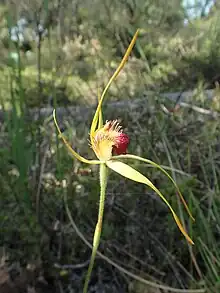| Carbunup king spider orchid | |
|---|---|
 | |
| Caladenia procera growing near Dunsborough | |
| Scientific classification | |
| Kingdom: | Plantae |
| Clade: | Tracheophytes |
| Clade: | Angiosperms |
| Clade: | Monocots |
| Order: | Asparagales |
| Family: | Orchidaceae |
| Subfamily: | Orchidoideae |
| Tribe: | Diurideae |
| Genus: | Caladenia |
| Species: | C. procera |
| Binomial name | |
| Caladenia procera | |
| Synonyms | |
Caladenia procera, commonly known as the Carbunup king spider orchid, is a species of orchid endemic to the south-west of Western Australia. It has a single erect, hairy leaf and up to four greenish-yellow and red flowers. It is one of the tallest and has amongst the largest flowers of the spider orchids.
Description
Caladenia procera is a terrestrial, perennial, deciduous, herb with an underground tuber and which occurs as single plants or in small clumps. It has a single erect, pale green, hairy leaf, 200–450 mm (8–20 in) long and 6–14 mm (0.2–0.6 in) wide. Up to four greenish-yellow and red flowers 100–140 mm (4–6 in) long, 80–100 mm (3–4 in) wide are borne on a stalk 350–900 mm (10–40 in) tall. The sepals have thick, yellowish-brown, club-like glandular ends 15–25 mm (0.6–1 in) long. The dorsal sepal is erect, 50–70 mm (2–3 in) long and 4–5 mm (0.16–0.20 in) wide. The lateral sepals are 55–65 mm (2–3 in) long and 6–8 mm (0.2–0.3 in) wide and turn downward so that they are about parallel to each other. The petals are 35–45 mm (1–2 in) long, about 5 mm (0.2 in) wide and upswept. The labellum is 22–30 mm (0.9–1 in) long, 15–20 mm (0.6–0.8 in) wide and greenish-yellow with a red tip which curls under. The sides of the labellum have yellowish, linear teeth up to 10 mm (0.4 in) long and there are four rows of red calli up to 3 mm (0.1 in) long, along the mid-line of the labellum. Flowering occurs from September to October.[2][3][4][5][6]
Taxonomy and naming
Caladenia procera was first described in 2001 by Stephen Hopper and Andrew Phillip Brown from a specimen collected near Carbunup River and the description was published in Nuytsia.[1] The specific epithet (procera) is a Latin word meaning "tall", "slender" or "long"[7] referring to the tall flowering stem of this orchid.[3]
Distribution and habitat
The Carbunup king spider orchid is found in a few locations south-west of Busselton in the Swan Coastal Plain biogeographic region where it grows in jarrah, marri and peppermint woodland.[2][3][5][8]
Conservation
Caladenia procera is classified as "Threatened Flora (Declared Rare Flora — Extant)" by the Western Australian Government Department of Parks and Wildlife and is listed as "Critically Endangered" under the Australian government Environment Protection and Biodiversity Conservation Act 1999. The main threats to the species are land clearing, road and firebreak maintenance and inappropriate fire regimes.[5][6][8]
References
- 1 2 "Caladenia procera". APNI. Retrieved 7 March 2017.
- 1 2 Jones, David L. (2006). A complete guide to native orchids of Australia including the island territories. Frenchs Forest, N.S.W.: New Holland. p. 108. ISBN 1877069124.
- 1 2 3 Brown, Andrew; Dundas, Pat; Dixon, Kingsley; Hopper, Stephen (2008). Orchids of Western Australia. Crawley, Western Australia: University of Western Australia Press. p. 69. ISBN 9780980296457.
- ↑ Hoffman, Noel; Brown, Andrew (2011). Orchids of South-West Australia (3rd ed.). Gooseberry Hill: Noel Hoffman. p. 32. ISBN 9780646562322.
- 1 2 3 "Approved conservation advice for Caladenia procera (Carbunup spider orchid)" (PDF). Australian Government Department of the Environment. Retrieved 7 March 2017.
- 1 2 "Carbunup king spider orchid (Caladenia procera") recovery plan" (PDF). Australian Government Department of the Environment. Retrieved 7 March 2017.
- ↑ Brown, Roland Wilbur (1956). The Composition of Scientific Words. Washington, D.C.: Smithsonian Institution Press. p. 410.
- 1 2 "Caladenia procera". FloraBase. Western Australian Government Department of Biodiversity, Conservation and Attractions.
